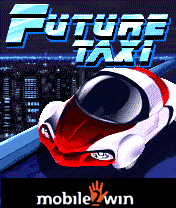Future
Taxi 
Its 2035 A.D! Lots has changed but people still use cabs. New space age ones! Earn a living speeding round the city in your cab, delivering your passengers to their destinations quickly and safely. You’ve got to be rough and tough to survive the street competition! Do you have it in you?
How2play
1. Pull up at a taxi stand to pick up and drop passengers.
2 .Use the arrow to make it to your destination! Make sure you have enough fuel!
Features
It's fast paced cut throat competition in the streets of a city! Do you have it in you?
Controls:
Tap 2 or UP to accelerate
Tap 8 or DOWN to slow down / reverse
Every tap increases / decreases your speed by 10 kmph.
Use 4 or LEFT to turn left
Use 6 or RIGHT to turn right
Drive over fuel cells to fill up on fuel.
The game ends if the user collides with another car / when he successfully completes one day.
players interested in this game are advised to look at one of the following games: PocketBowling 19Solitaire
what is j2me?
The first edition for the Java platform was
Java 2 Standard Edition (J2SE), which supported
the development of desktop applications. The
fundamental idea was to provide a language which
supported platform-independent code.
Shortly after, a new edition was released, Java
2 Enterprise Edition (J2EE), providing support for
large-scale, enterprise-wide applications.
As we enter the post-PC era, the market for
network-connected consumer devices - such as smart
mobile phones, televisions, VCRs and PDAs - is
expected to grow at a phenomenal rate. In order to
provide a compelling Java technology solution for
these devices, Sun has introduced the latest
addition to the Java platform: Java 2 Micro
Edition (J2ME).
Within J2ME, there are two broad categories,
known as configurations. Connected Device
Configuration (CDC) is a set of APIs to support
fixed devices such as a television set-top box.
Connected Limited Device Configuration (CLDC) is a
set of APIs targeted at devices that have limited
processing power, display and memory. The majority
of these devices will also be mobile.
On top of configurations are profiles. Profiles
provide APIs for user interface design, network
support, and persistent storage. The Mobile
Information Device Profile (MIDP) is a set of Java
APIs which, together with the CLDC, provides a
complete J2ME application runtime environment
targeted at mobile devices, such as mobile phones,
pagers and entry level PDAs.
|  اللغة العربية
اللغة العربية اللغة العربية
اللغة العربية